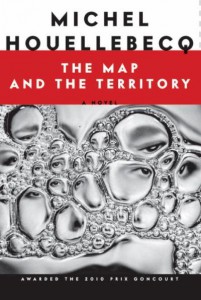Tr. from French by Gavin Bowd
In 1998, Michel Houellebecq was awarded the Prix Novembre for his second novel, Les Particules Élémentaires, despite strong objections from some members of the jury. As Julian Barnes, one of the judges for the award that year, reported in the New Yorker, “one female member of our jury declared that she had admired the novel until she watched its author on television.” Confirming her negative estimation, Houellebecq turned up to claim his $30,000 prize, “a shabby figure in a baggy sweater and rumpled scarlet jeans,” declining, “to wallow in bourgeois expressions of pleasure or gratitude.” According to Barnes, the offense was so great that the Prix Novembre was suspended for the following year so that the jury members could, “discuss its future direction.” Several months later Knopf published an English translation of The Elementary Particles and American readers were given their chance to squirm at the public face of France’s literary scene; he greeted his New York Times profiler by drinking to the point of briefly passing out at the dinner table, yet regained his wits enough to later inform his guest that he would only continue the interview if she slept with him.
For those familiar with Houellebecq’s public persona – or the bleak outlook of his previous four novels which document the foreclosed avenues of redemption available to modern subjects – the writer’s recent response to receiving the Prix Goncourt (France’s top literary honor) for The Map and the Territory is likely to give pause. “It’s a strange feeling,” he told reporters, “but I’m deeply happy.”
Such an unlikely, amiable response, which so contrasts his reception of the Prix Novembre, gives good reason to ask whether there is anything internal to the text that can explain Houellebecq’s changed tone towards France’s literary establishment, or vice versa (the 1998 Prix Novembre was awarded to him in part because the Prix Goncourt’s jury couldn’t bear to bestow him the honor despite a wide consensus on the quality of his novel). As with his previous novels, the protagonist of The Map and the Territory, the artist Jed Marti, reflects a certain flatness that has colonized most spheres of everyday life. Yet instead of demonstrating the perhaps necessary ways in which we fail to achieve happiness or fulfillment over the course of a lifetime – in our work, in our relationships, and especially in the sexual realm – each period of Jed’s life contains at least a satisfying sense of resolution.
The novel follows Jed over the course of his development, each phase of his life marked by the contents of his artistic output. He begins as a photographer of small objects of production (“nuts, bolts, and adjusting knobs appeared like so many jewels, gleaming discretely”), and then as a documenter of the luscious quality of Michelin road maps. This period culminates in an exhibition called “The Map is More Interesting Than the Territory,” which establishes Jed as a financial and critical success. Later he completes a series of portraits entitled “The Series of Simple Professions,” whose subjects include a bartender, a prostitute, Jed’s father (The Architect Jean-Pierre Martin Leaving the Management of His Business), Steve Jobs and Bill Gates (Bill Gates and Steve Jobs Discussing the Future of Information Technology), and the author Michel Houellebecq (Michel Houellebecq, Writer). In a rare interview with Art Press, Jed offers the following statement of his work: “I want to give an account of the world…I want simply to give an account of the world.”
The insertion into the novel of Houellebecq himself, along with a host of other real figures in contemporary French art and media, provides another platform for playing with the possibility of accurate representation in a media saturated age. The drunken, vulgar, hermit-like Houellebecq character reflects the negative appraisal of the Prix Novembre jury member, and the death he treats himself to in the third act – one of the more memorable deaths in contemporary literature – appears like an act of wish-fulfillment for many in the French establishment.
The Map and the Territory avoids much of the melodramatic overtones of his previous work; the polemical speeches (bold or reactionary according to your commitments) are kept to a minimum, and the hedonism is certainly toned down. Instead we have the writer, like the artist he writes of, engaged in his work, trying to document through his narrative of one man’s life the meaningful purposes to which our efforts might be put as well as the myriad ways in which we might fall short. There is no Romantic gesture that sets this text at a privileged position from which the reader should derive prescriptions for our age of generalized crisis. Rather, like his character Jed, Houellebecq appears more interested in trying to render his subject as accurately as possible, and this allows him to stage his most convincing meditations to date on death, renown, contentment, art, tourism, and the bourgeoisie (which, thankfully, are still not spared the author’s ire). Readers should be grateful, not disquieted, for these provocations.
Whether such an achievement marks the end of a phase in the artist’s career (say, as an iconoclast) is another question. As the character Houellebecq responds to Jed’s offer to paint his portrait in remuneration for writing his catalogue: “A painting. Well, I have walls to hang it on. It’s the only thing I really have, in my life: walls.” Through the act of doubling his own artistic practice in Jed we can perhaps read this as a writer accepting his peculiar vocation. As an enthusiastic reader of Houellebecq, this is a comforting thought.
This post may contain affiliate links.









